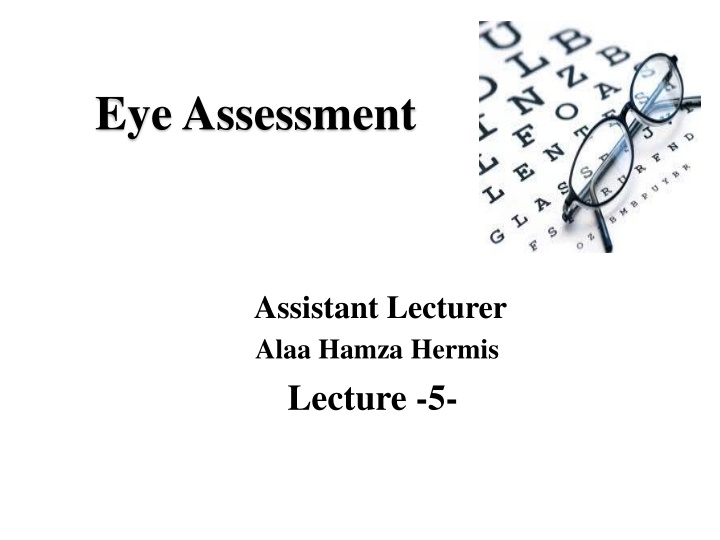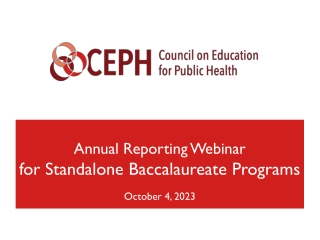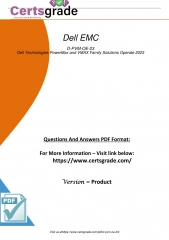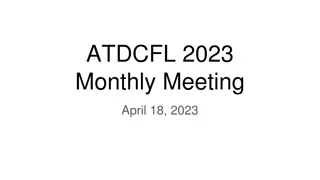
Eye Assessment Lecture: Skills, Documentation, and Equipment
Learn how to safely and accurately assess the eye, document assessment data, and use essential equipment in this comprehensive lecture. Explore subjective data, examine external eye structures, assess the conjunctiva, evaluate pupil responses, and more.
Download Presentation

Please find below an Image/Link to download the presentation.
The content on the website is provided AS IS for your information and personal use only. It may not be sold, licensed, or shared on other websites without obtaining consent from the author. If you encounter any issues during the download, it is possible that the publisher has removed the file from their server.
You are allowed to download the files provided on this website for personal or commercial use, subject to the condition that they are used lawfully. All files are the property of their respective owners.
The content on the website is provided AS IS for your information and personal use only. It may not be sold, licensed, or shared on other websites without obtaining consent from the author.
E N D
Presentation Transcript
Eye Assessment Assistant Lecturer Alaa Hamza Hermis Lecture -5-
Objectives: students will be able to: 1. Demonstrate the ability to safely & accurately complete a comprehensive examination of the eye. 2. Demonstrate the ability to accurately document eye assessment data in organized manner.
Equipment Needed 1 . Snellen Chart 2. Near-vision chart 3. Cover card 4. Penlight 5. Ophthalmoscope 6. Ruler
Subjective data: 1. Vision difficulty (decrease acuity) 2. Redness, swelling 3. Glaucoma (blurring, blind spots) 4. Pain 5, Watering, discharge 6. Use of glasses or contact lenses 7. Strabismus, diplopia (Double Vision) 8. Past history of ocular problems 9. Self-care behaviors
External Eye Structures: Eye brow: for shape, movement , hair distribution : normal finding revealed symmetrical in shape intact skin and evenly hair distribution , symmetrical movement Eye lashes : evenly hair distribution ,curl directed outward Eye lids : inspect for color ,lesion and movement : color same as the face no discoloration , free of lesion and discharge when lids closed it should be symmetrical complete , sclera not visible
Assess bulbar conjunctiva ( cover the eye ball and sclera : transparent ,sclera white or yellow. capillary appears free of lesion ( retract) Assess palpebral conjunctiva line the eye lid normal finding pink to red ,shiny smooth free of discharge and lesion.
By using gauze or cotton touch the client cornea blinking indicate that the trigeminal (5th) nerve is intact
Inspect pupil : black in color , equal in size normally 3-7mm in diameter and round ,iris flat and rounded Assess pupil for: Direct reaction to light: pupil constrict ( penlight) Reaction to Accommodation : Penlight placed 10cm or 4 in near nose bridge , normal finding pupil constrict when looking on near object and dilated on far object. Documentation: PERRLA (pupils equal round reacting to light and accommodation)
Assess Lacrimal Gland Sac and Nasolacrimal duct Inspect and use index to palpate : Free of edema ,no tenderness ,no excessive tearing Lacrimal gland in outer eye canthus Lacrimal sac and duct inner canthus of eye
Exteraoccular Muscle Test Stand direct in front of the client use penlight within 1ft distance (30 cm) ask the client to follow the object move toward 6 cardinal direction . Normal finding both eye coordinated movement Abnormal: eye fail to follow the object squint and strabismus ( cross eye) Nystagmus : caused by nerve impairment
How is visual field testing done? Visual field testing is performed on one eye at a time, with the opposite eye completely covered to avoid errors. In all testing, the patient must look straight ahead at all times in order to avoid testing the central vision rather than the periphery.
The reasons for this test are the following : * visual field testing is useful screening for glaucoma. *testing patient with glaucoma for treatment response. *screening and testing for lid droop or ptosis, particularly for insurance approval of lid lift surgical procedures.
Visual acuity: Near vision: within 30-36cm distance ask the client to read newspaper or magazine with keeping glass or lenses
Distance vision test within 20 feet or 6 meter by using snellen chart the client read the chart line from top to bottom . First number 20 indicate the distance Between the chart &client Second number 20 indicate The distance that normal Eye can read Glass and lenses kept
Distance from the chart D (Distant) for the evaluation done at 20 feet (or 6 meters). N (Near) for the evaluation done at 14 inches (or 36 cm). Eye evaluated OD (Latin oculus dexter) for the right eye. OS (Latin oculus sinister) for the left eye. OU (Latin oculi uterque) for both eyes. CC (Latin cum correctors) with correctors. SC (Latin sine correctors) without correctors
Performing functional vision test 1- light perception: penlight from lateral than off ask client about light if he recognize documentation : LP+ 2- Hand movement within 30 cm 1 feet move hand back ,front than stop ask client when it stopped doc: H\M 1ft + 3- Counting finger within 30 cm or 1 ft ask the client number of finger doc: F\C+
Ophthalmoscope: A lighted instrument, one of the most important tools for examining the optic disc. Normal orange to pink with vessel appearance Abnormal pale red spot











